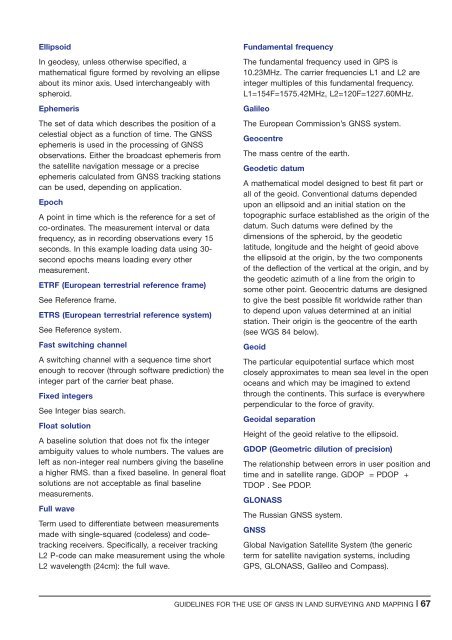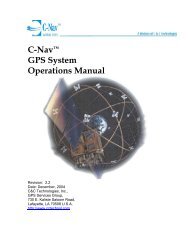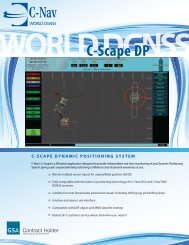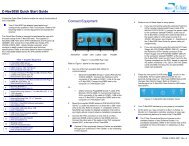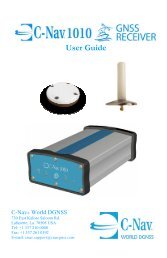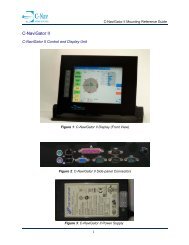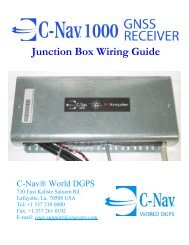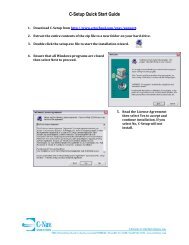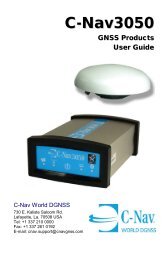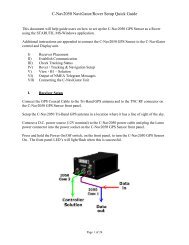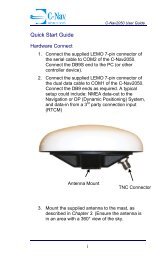Guidelines for the use of GNSS in surveying and mapping
Guidelines for the use of GNSS in surveying and mapping
Guidelines for the use of GNSS in surveying and mapping
Create successful ePaper yourself
Turn your PDF publications into a flip-book with our unique Google optimized e-Paper software.
Ellipsoid<br />
In geodesy, unless o<strong>the</strong>rwise specified, a<br />
ma<strong>the</strong>matical figure <strong>for</strong>med by revolv<strong>in</strong>g an ellipse<br />
about its m<strong>in</strong>or axis. Used <strong>in</strong>terchangeably with<br />
spheroid.<br />
Ephemeris<br />
The set <strong>of</strong> data which describes <strong>the</strong> position <strong>of</strong> a<br />
celestial object as a function <strong>of</strong> time. The <strong>GNSS</strong><br />
ephemeris is <strong>use</strong>d <strong>in</strong> <strong>the</strong> process<strong>in</strong>g <strong>of</strong> <strong>GNSS</strong><br />
observations. Ei<strong>the</strong>r <strong>the</strong> broadcast ephemeris from<br />
<strong>the</strong> satellite navigation message or a precise<br />
ephemeris calculated from <strong>GNSS</strong> track<strong>in</strong>g stations<br />
can be <strong>use</strong>d, depend<strong>in</strong>g on application.<br />
Epoch<br />
A po<strong>in</strong>t <strong>in</strong> time which is <strong>the</strong> reference <strong>for</strong> a set <strong>of</strong><br />
co-ord<strong>in</strong>ates. The measurement <strong>in</strong>terval or data<br />
frequency, as <strong>in</strong> record<strong>in</strong>g observations every 15<br />
seconds. In this example load<strong>in</strong>g data us<strong>in</strong>g 30-<br />
second epochs means load<strong>in</strong>g every o<strong>the</strong>r<br />
measurement.<br />
ETRF (European terrestrial reference frame)<br />
See Reference frame.<br />
ETRS (European terrestrial reference system)<br />
See Reference system.<br />
Fast switch<strong>in</strong>g channel<br />
A switch<strong>in</strong>g channel with a sequence time short<br />
enough to recover (through s<strong>of</strong>tware prediction) <strong>the</strong><br />
<strong>in</strong>teger part <strong>of</strong> <strong>the</strong> carrier beat phase.<br />
Fixed <strong>in</strong>tegers<br />
See Integer bias search.<br />
Float solution<br />
A basel<strong>in</strong>e solution that does not fix <strong>the</strong> <strong>in</strong>teger<br />
ambiguity values to whole numbers. The values are<br />
left as non-<strong>in</strong>teger real numbers giv<strong>in</strong>g <strong>the</strong> basel<strong>in</strong>e<br />
a higher RMS. than a fixed basel<strong>in</strong>e. In general float<br />
solutions are not acceptable as f<strong>in</strong>al basel<strong>in</strong>e<br />
measurements.<br />
Full wave<br />
Term <strong>use</strong>d to differentiate between measurements<br />
made with s<strong>in</strong>gle-squared (codeless) <strong>and</strong> codetrack<strong>in</strong>g<br />
receivers. Specifically, a receiver track<strong>in</strong>g<br />
L2 P-code can make measurement us<strong>in</strong>g <strong>the</strong> whole<br />
L2 wavelength (24cm): <strong>the</strong> full wave.<br />
Fundamental frequency<br />
The fundamental frequency <strong>use</strong>d <strong>in</strong> GPS is<br />
10.23MHz. The carrier frequencies L1 <strong>and</strong> L2 are<br />
<strong>in</strong>teger multiples <strong>of</strong> this fundamental frequency.<br />
L1=154F=1575.42MHz, L2=120F=1227.60MHz.<br />
Galileo<br />
The European Commission’s <strong>GNSS</strong> system.<br />
Geocentre<br />
The mass centre <strong>of</strong> <strong>the</strong> earth.<br />
Geodetic datum<br />
A ma<strong>the</strong>matical model designed to best fit part or<br />
all <strong>of</strong> <strong>the</strong> geoid. Conventional datums depended<br />
upon an ellipsoid <strong>and</strong> an <strong>in</strong>itial station on <strong>the</strong><br />
topographic surface established as <strong>the</strong> orig<strong>in</strong> <strong>of</strong> <strong>the</strong><br />
datum. Such datums were def<strong>in</strong>ed by <strong>the</strong><br />
dimensions <strong>of</strong> <strong>the</strong> spheroid, by <strong>the</strong> geodetic<br />
latitude, longitude <strong>and</strong> <strong>the</strong> height <strong>of</strong> geoid above<br />
<strong>the</strong> ellipsoid at <strong>the</strong> orig<strong>in</strong>, by <strong>the</strong> two components<br />
<strong>of</strong> <strong>the</strong> deflection <strong>of</strong> <strong>the</strong> vertical at <strong>the</strong> orig<strong>in</strong>, <strong>and</strong> by<br />
<strong>the</strong> geodetic azimuth <strong>of</strong> a l<strong>in</strong>e from <strong>the</strong> orig<strong>in</strong> to<br />
some o<strong>the</strong>r po<strong>in</strong>t. Geocentric datums are designed<br />
to give <strong>the</strong> best possible fit worldwide ra<strong>the</strong>r than<br />
to depend upon values determ<strong>in</strong>ed at an <strong>in</strong>itial<br />
station. Their orig<strong>in</strong> is <strong>the</strong> geocentre <strong>of</strong> <strong>the</strong> earth<br />
(see WGS 84 below).<br />
Geoid<br />
The particular equipotential surface which most<br />
closely approximates to mean sea level <strong>in</strong> <strong>the</strong> open<br />
oceans <strong>and</strong> which may be imag<strong>in</strong>ed to extend<br />
through <strong>the</strong> cont<strong>in</strong>ents. This surface is everywhere<br />
perpendicular to <strong>the</strong> <strong>for</strong>ce <strong>of</strong> gravity.<br />
Geoidal separation<br />
Height <strong>of</strong> <strong>the</strong> geoid relative to <strong>the</strong> ellipsoid.<br />
GDOP (Geometric dilution <strong>of</strong> precision)<br />
The relationship between errors <strong>in</strong> <strong>use</strong>r position <strong>and</strong><br />
time <strong>and</strong> <strong>in</strong> satellite range. GDOP = PDOP +<br />
TDOP . See PDOP.<br />
GLONASS<br />
The Russian <strong>GNSS</strong> system.<br />
<strong>GNSS</strong><br />
Global Navigation Satellite System (<strong>the</strong> generic<br />
term <strong>for</strong> satellite navigation systems, <strong>in</strong>clud<strong>in</strong>g<br />
GPS, GLONASS, Galileo <strong>and</strong> Compass).<br />
GUIDELINES FOR THE USE OF <strong>GNSS</strong> IN LAND SURVEYING AND MAPPING |67


